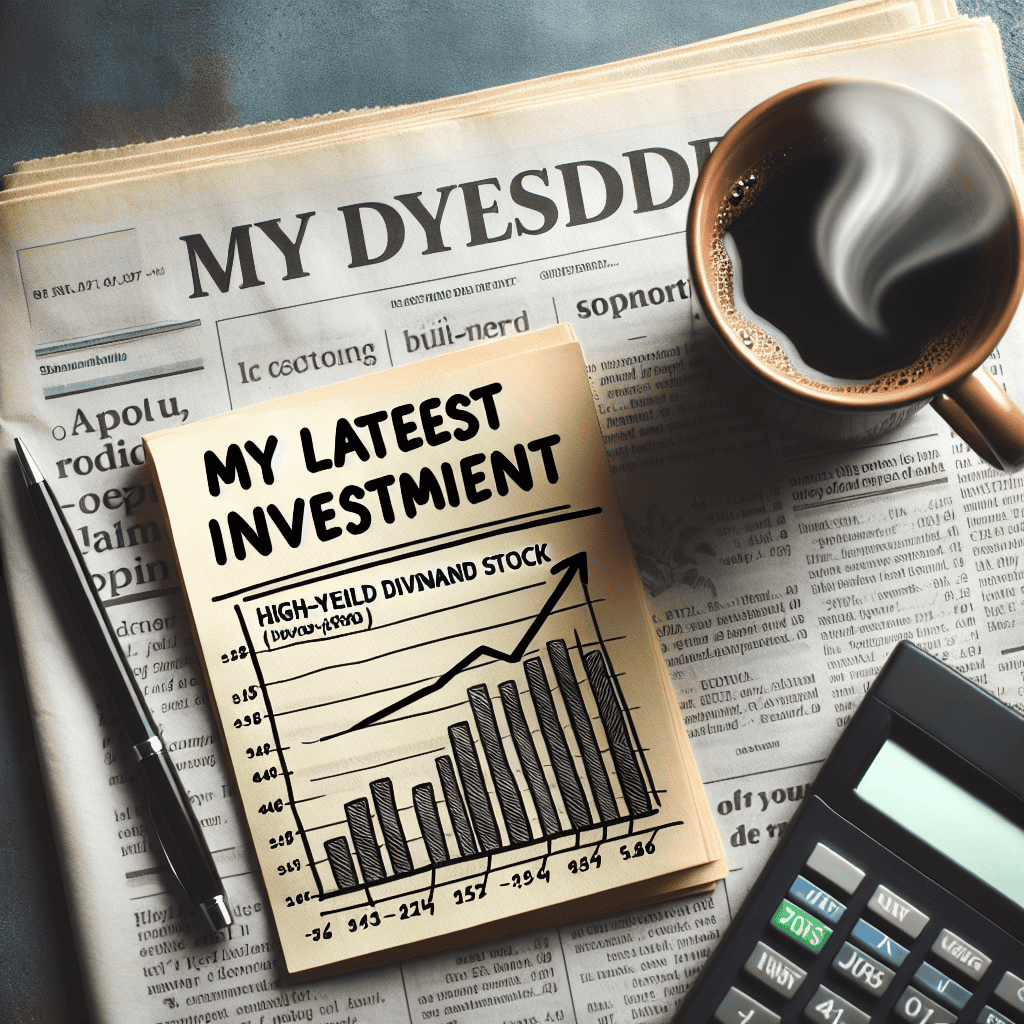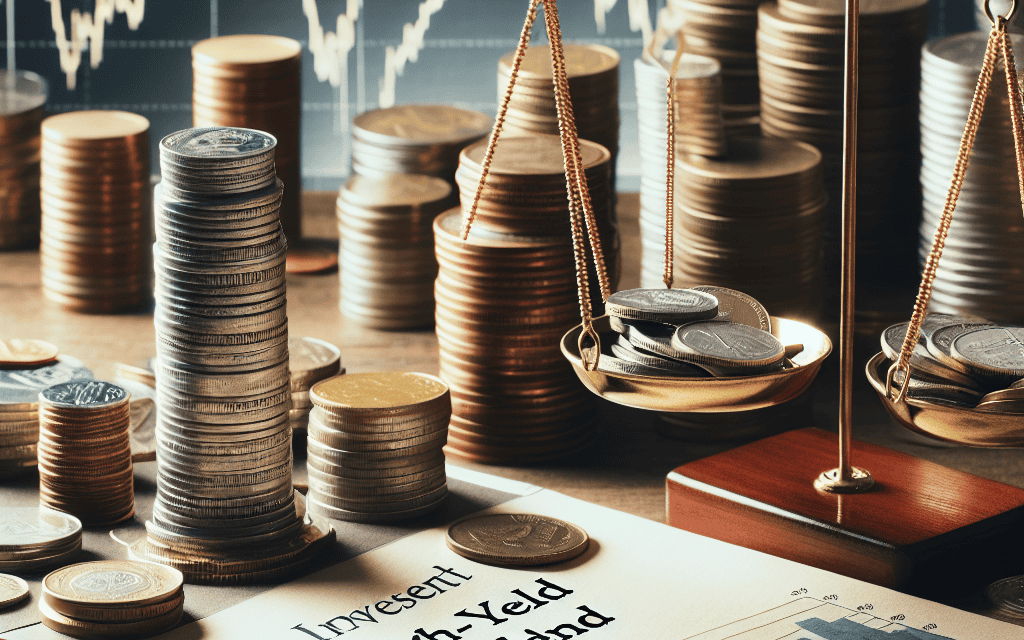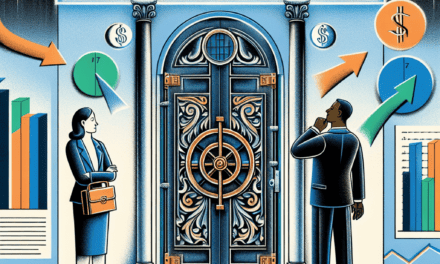“Watch Your Wealth Grow: Invest in High-Yield Dividends Today!”
Introduction
Investing in high-yield dividend stocks can be a strategic move for those seeking to generate a steady stream of income while potentially benefiting from capital appreciation. My latest investment in a high-yield dividend stock represents a calculated decision to enhance my portfolio’s income-generating potential. This investment not only promises attractive dividend payouts but also aligns with my long-term financial goals by offering the possibility of growth in value. By carefully selecting a stock with a strong track record of dividend payments and a solid financial foundation, I aim to achieve a balance between risk and reward, ensuring that my investment contributes positively to my overall financial strategy.
Understanding High-Yield Dividend Stocks: A Beginner’s Guide
Investing in high-yield dividend stocks can be an attractive strategy for those seeking a steady income stream while also participating in the potential for capital appreciation. As a beginner, understanding the nuances of high-yield dividend stocks is crucial to making informed investment decisions. My latest investment in a high-yield dividend stock has provided me with valuable insights into this investment approach, which I am eager to share.
To begin with, high-yield dividend stocks are shares of companies that pay out dividends at a higher rate compared to the average market yield. These dividends are typically distributed from the company’s profits and are a way for companies to reward shareholders for their investment. The allure of high-yield dividend stocks lies in their ability to generate regular income, which can be particularly appealing in a low-interest-rate environment where traditional savings accounts and bonds offer minimal returns.
However, it is important to recognize that not all high-yield dividend stocks are created equal. While the prospect of high returns is enticing, it is essential to assess the sustainability of the dividend payments. A high dividend yield may sometimes indicate underlying financial distress within a company, as the stock price may have fallen significantly, thereby inflating the yield. Therefore, conducting thorough research into the company’s financial health, earnings stability, and dividend payout history is imperative.
In my recent investment journey, I focused on identifying companies with a strong track record of consistent dividend payments and a commitment to maintaining or increasing these payouts over time. This approach led me to invest in a well-established utility company known for its reliable cash flow and prudent financial management. Utility companies often have stable revenue streams due to the essential nature of their services, making them a popular choice for dividend-focused investors.
Moreover, diversification plays a critical role in managing risk when investing in high-yield dividend stocks. By spreading investments across different sectors and industries, one can mitigate the impact of sector-specific downturns on their overall portfolio. In my case, I complemented my investment in the utility sector with shares in a telecommunications company and a consumer goods firm, both of which have demonstrated resilience and a commitment to shareholder returns.
Another key consideration is the tax implications of dividend income. Depending on the jurisdiction, dividends may be subject to different tax rates compared to capital gains. It is advisable to consult with a tax professional to understand the specific tax treatment of dividends in your region and to explore tax-efficient investment accounts that may help optimize after-tax returns.
Furthermore, it is essential to remain vigilant and regularly review the performance of your high-yield dividend stocks. Market conditions and company fundamentals can change, necessitating adjustments to your investment strategy. Staying informed about industry trends, economic indicators, and company-specific developments can help you make timely decisions to protect and grow your investment.
In conclusion, investing in high-yield dividend stocks can be a rewarding strategy for generating income and building wealth over time. By carefully selecting companies with sustainable dividends, diversifying across sectors, and understanding the tax implications, investors can enhance their chances of success. My latest investment has reinforced the importance of due diligence and strategic planning in navigating the world of high-yield dividend stocks, providing a solid foundation for future investment endeavors.
The Benefits Of Investing In High-Yield Dividend Stocks
Investing in high-yield dividend stocks has long been a favored strategy among investors seeking both income and growth. These stocks, which offer dividends that are significantly higher than the average yield of the broader market, provide a unique blend of benefits that can enhance an investment portfolio. As I reflect on my latest investment in a high-yield dividend stock, I am reminded of the numerous advantages that such investments can offer.
To begin with, high-yield dividend stocks provide a steady stream of income, which can be particularly appealing in times of market volatility. Unlike growth stocks, which may not pay dividends and rely on capital appreciation for returns, high-yield dividend stocks offer regular payouts. This consistent income can be reinvested to purchase additional shares, thereby compounding returns over time, or it can be used to meet personal financial needs. For retirees or those seeking passive income, this feature is especially beneficial, as it provides a reliable source of cash flow.
Moreover, high-yield dividend stocks often belong to well-established companies with stable earnings. These companies typically have a long history of profitability and a commitment to returning capital to shareholders. As a result, investing in such stocks can offer a degree of safety and predictability. While no investment is without risk, the stability of these companies can provide a buffer against market downturns. This is particularly important for risk-averse investors who prioritize capital preservation.
In addition to income and stability, high-yield dividend stocks can also offer attractive total returns. While the primary appeal of these stocks is their dividend yield, they can also appreciate in value over time. Companies that consistently pay high dividends often have strong fundamentals and competitive advantages in their industries. As these companies grow and expand, their stock prices can rise, providing capital gains in addition to dividend income. This dual potential for income and growth makes high-yield dividend stocks a compelling choice for a balanced investment strategy.
Furthermore, investing in high-yield dividend stocks can serve as a hedge against inflation. As the cost of living rises, the purchasing power of fixed income streams can erode. However, companies that pay high dividends often have the ability to increase their payouts over time, thereby helping investors maintain their purchasing power. This potential for dividend growth can be a crucial factor in preserving wealth in an inflationary environment.
It is also worth noting that high-yield dividend stocks can enhance portfolio diversification. By including these stocks in a portfolio, investors can gain exposure to different sectors and industries, reducing the overall risk. Diversification is a fundamental principle of investing, as it helps mitigate the impact of poor performance in any single investment. High-yield dividend stocks, with their unique characteristics, can complement other asset classes and contribute to a well-rounded portfolio.
In conclusion, my latest investment in a high-yield dividend stock underscores the myriad benefits that such investments can offer. From providing a steady income stream and stability to offering potential for growth and serving as an inflation hedge, high-yield dividend stocks are a valuable addition to any investment strategy. As I continue to build my portfolio, I am confident that these stocks will play a crucial role in achieving my financial goals.
How To Evaluate A High-Yield Dividend Stock For Your Portfolio
Investing in high-yield dividend stocks can be an attractive strategy for those seeking a steady income stream and potential capital appreciation. However, evaluating such stocks requires a comprehensive approach to ensure they align with your financial goals and risk tolerance. The first step in this evaluation process is to assess the dividend yield itself. A high dividend yield can be enticing, but it is crucial to understand the sustainability of these payouts. A yield that appears too good to be true might indicate underlying financial distress or an unsustainable payout ratio. Therefore, it is essential to examine the company’s earnings and cash flow to determine if it can maintain or grow its dividend over time.
In addition to analyzing the dividend yield, it is important to consider the company’s payout ratio. This ratio, which measures the proportion of earnings paid out as dividends, provides insight into how much of the company’s profits are being returned to shareholders. A payout ratio that is too high may suggest that the company is overextending itself, potentially jeopardizing future dividend payments. Conversely, a lower payout ratio might indicate that the company has room to increase dividends, which could be a positive sign for investors seeking growth in their income stream.
Another critical factor to evaluate is the company’s financial health. A strong balance sheet with manageable debt levels is essential for a company to sustain its dividend payments, especially during economic downturns. Analyzing key financial metrics such as the debt-to-equity ratio and interest coverage ratio can provide a clearer picture of the company’s financial stability. Companies with high levels of debt may struggle to maintain dividends if they face financial challenges, making it imperative to assess their ability to service debt obligations.
Furthermore, understanding the company’s business model and industry dynamics is vital. Companies operating in stable, non-cyclical industries are often better positioned to provide consistent dividends. For instance, utilities and consumer staples are sectors known for their resilience and ability to generate steady cash flows, even in challenging economic conditions. On the other hand, companies in highly cyclical industries may experience fluctuations in earnings, which could impact their ability to maintain dividend payments.
Additionally, it is beneficial to examine the company’s dividend history. A track record of consistent or growing dividends over several years can be a strong indicator of management’s commitment to returning value to shareholders. Companies with a history of dividend cuts or erratic payments may pose a higher risk to income-focused investors. Therefore, reviewing past dividend performance can provide valuable insights into the company’s future dividend prospects.
Finally, consider the broader economic environment and its potential impact on the company’s operations. Factors such as interest rates, inflation, and regulatory changes can influence a company’s profitability and, consequently, its ability to pay dividends. Staying informed about macroeconomic trends and their implications for the industry can help investors make more informed decisions.
In conclusion, evaluating a high-yield dividend stock for your portfolio involves a multifaceted analysis of the dividend yield, payout ratio, financial health, industry dynamics, dividend history, and economic environment. By carefully considering these factors, investors can identify stocks that not only offer attractive yields but also align with their long-term investment objectives. This thorough approach ensures that the chosen investments contribute positively to the overall portfolio, providing both income and potential growth.
My Latest Investment: Why I Chose This High-Yield Dividend Stock

In the ever-evolving landscape of financial markets, making informed investment decisions is crucial for achieving long-term financial goals. Recently, I embarked on a new investment journey by selecting a high-yield dividend stock, a decision driven by a combination of thorough research, strategic planning, and a keen understanding of market dynamics. This choice was not made lightly, as it involved a careful analysis of various factors that contribute to the potential success of such an investment.
To begin with, the allure of high-yield dividend stocks lies in their ability to provide a steady stream of income, which can be particularly appealing in times of market volatility. Unlike growth stocks, which primarily rely on capital appreciation, dividend stocks offer regular payouts, thus providing a cushion against market fluctuations. This characteristic aligns well with my investment strategy, which emphasizes stability and consistent returns. Moreover, the reinvestment of dividends can significantly enhance the compounding effect, leading to substantial wealth accumulation over time.
In selecting this particular high-yield dividend stock, I considered the company’s financial health and its track record of dividend payments. A robust balance sheet, strong cash flow, and a history of consistent dividend payouts are indicative of a company’s ability to sustain and potentially increase its dividends in the future. Furthermore, I evaluated the company’s position within its industry, assessing its competitive advantages and growth prospects. A company with a solid market position and a clear path for growth is more likely to maintain its dividend payments, even in challenging economic conditions.
Another critical factor in my decision-making process was the current economic environment. With interest rates remaining relatively low, traditional fixed-income investments such as bonds offer limited returns. In contrast, high-yield dividend stocks present an attractive alternative, providing higher income potential while still offering the possibility of capital appreciation. Additionally, the tax advantages associated with qualified dividends further enhance the appeal of this investment choice, as they are typically taxed at a lower rate than ordinary income.
While the potential benefits of investing in high-yield dividend stocks are compelling, it is essential to acknowledge the associated risks. Companies offering high dividend yields may face financial challenges, which could lead to dividend cuts or suspensions. Therefore, conducting comprehensive due diligence is paramount to mitigate these risks. This involves not only analyzing financial statements but also staying informed about industry trends and macroeconomic factors that could impact the company’s performance.
In conclusion, my decision to invest in a high-yield dividend stock was guided by a strategic approach that balances risk and reward. By focusing on companies with strong fundamentals, a history of reliable dividend payments, and favorable growth prospects, I aim to achieve a stable and growing income stream. This investment aligns with my broader financial objectives, providing both immediate income and long-term wealth accumulation potential. As with any investment, ongoing monitoring and reassessment are crucial to ensure that the stock continues to meet my expectations and adapts to changing market conditions. Through this disciplined approach, I am confident in the potential of this high-yield dividend stock to contribute positively to my investment portfolio.
Risks And Rewards: Navigating The High-Yield Dividend Stock Market
Investing in high-yield dividend stocks can be an enticing prospect for those seeking to enhance their income streams. These stocks, known for offering substantial dividend payouts relative to their share price, can provide a steady income, especially in a low-interest-rate environment. However, as with any investment, they come with their own set of risks and rewards that must be carefully navigated.
One of the primary attractions of high-yield dividend stocks is the potential for significant income generation. These stocks often belong to companies that have established a consistent track record of paying dividends, which can be particularly appealing to retirees or those looking to supplement their income. The allure of receiving regular payments can be a powerful motivator for investors, especially when compared to the often unpredictable nature of capital gains.
However, it is crucial to understand that high yields can sometimes be a red flag rather than a golden opportunity. A high dividend yield may indicate that a company’s stock price has fallen significantly, possibly due to underlying financial troubles. Therefore, while the yield may appear attractive, it is essential to conduct thorough research into the company’s financial health and future prospects. This involves examining the company’s earnings, cash flow, and payout ratio to ensure that the dividend is sustainable over the long term.
Moreover, high-yield dividend stocks can be sensitive to interest rate changes. When interest rates rise, these stocks may become less attractive compared to other fixed-income investments, such as bonds, which could lead to a decline in their stock prices. Consequently, investors must remain vigilant and consider the broader economic environment when investing in these stocks.
Another risk associated with high-yield dividend stocks is the potential for dividend cuts. Companies facing financial difficulties may reduce or eliminate their dividend payments to preserve cash, which can lead to a sharp decline in the stock’s price. Therefore, it is vital to diversify one’s portfolio to mitigate the impact of any single company’s dividend cut. Diversification across different sectors and industries can help spread risk and provide a more stable income stream.
Despite these risks, the rewards of investing in high-yield dividend stocks can be substantial. For those willing to conduct diligent research and maintain a diversified portfolio, these stocks can offer a reliable source of income and the potential for capital appreciation. Additionally, reinvesting dividends can compound returns over time, further enhancing the investment’s overall performance.
In conclusion, while high-yield dividend stocks present an attractive opportunity for income generation, they require careful consideration and strategic planning. By understanding the risks involved and taking steps to mitigate them, investors can navigate the high-yield dividend stock market with greater confidence. It is essential to remain informed about the companies in which one invests and to stay attuned to changes in the economic landscape. With a balanced approach, high-yield dividend stocks can be a valuable component of a well-rounded investment portfolio, offering both income and growth potential.
Diversifying Your Portfolio With High-Yield Dividend Stocks
In the ever-evolving landscape of financial markets, investors are constantly seeking opportunities to enhance their portfolios while mitigating risk. One such strategy that has gained traction is the inclusion of high-yield dividend stocks. These stocks not only offer the potential for capital appreciation but also provide a steady stream of income through dividends. Recently, I made a strategic decision to invest in a high-yield dividend stock, a move that aligns with my broader goal of diversifying my investment portfolio.
High-yield dividend stocks are particularly appealing to investors who prioritize income generation. Unlike growth stocks, which reinvest profits to fuel expansion, dividend stocks distribute a portion of their earnings to shareholders. This characteristic makes them an attractive option for those seeking regular income, especially in a low-interest-rate environment. Moreover, these stocks often belong to well-established companies with a history of stable earnings, adding a layer of security to the investment.
In selecting a high-yield dividend stock, it is crucial to conduct thorough research and analysis. Factors such as the company’s dividend payout ratio, historical dividend growth, and financial health should be carefully evaluated. A high dividend yield may be enticing, but it is essential to ensure that the company can sustain its dividend payments over the long term. In my case, I focused on a company with a robust track record of consistent dividend payments and a strong balance sheet, which provided confidence in its ability to weather economic fluctuations.
Furthermore, high-yield dividend stocks can play a pivotal role in diversifying an investment portfolio. Diversification is a fundamental principle in investing, aimed at reducing risk by spreading investments across various asset classes and sectors. By incorporating dividend stocks, investors can achieve a balance between growth and income, thereby enhancing the overall stability of their portfolio. This approach is particularly beneficial during market downturns, as the income generated from dividends can help offset potential losses from other investments.
Another advantage of high-yield dividend stocks is their potential to act as a hedge against inflation. As the cost of living rises, the purchasing power of fixed-income investments may erode. However, companies that consistently increase their dividends can provide a growing income stream that keeps pace with inflation. This characteristic makes dividend stocks an attractive option for long-term investors seeking to preserve their wealth.
While the benefits of high-yield dividend stocks are compelling, it is important to acknowledge the associated risks. Companies may reduce or suspend dividend payments during periods of financial distress, which can impact the stock’s value and the investor’s income. Therefore, it is prudent to diversify within the dividend stock category itself, selecting companies from different industries and regions to mitigate sector-specific risks.
In conclusion, my recent investment in a high-yield dividend stock represents a strategic step towards achieving a well-rounded and diversified portfolio. By carefully selecting a company with a strong dividend history and financial stability, I aim to benefit from both capital appreciation and a reliable income stream. As with any investment strategy, due diligence and a long-term perspective are essential to navigating the complexities of the financial markets. Through thoughtful diversification and a focus on high-quality dividend stocks, investors can enhance their portfolios and work towards their financial goals with greater confidence.
Long-Term Growth: The Role Of High-Yield Dividend Stocks In Wealth Building
In the realm of wealth building, the strategic selection of investment vehicles plays a pivotal role in achieving long-term financial goals. Among the myriad options available, high-yield dividend stocks have emerged as a compelling choice for investors seeking both income and growth. My latest investment in a high-yield dividend stock exemplifies the potential of this approach, offering insights into how such stocks can contribute to a robust financial portfolio.
High-yield dividend stocks are shares in companies that distribute a significant portion of their earnings to shareholders in the form of dividends. These dividends provide a steady income stream, which can be particularly appealing in volatile market conditions. By reinvesting these dividends, investors can harness the power of compounding, thereby accelerating the growth of their investment over time. This dual benefit of income and growth makes high-yield dividend stocks an attractive option for those focused on long-term wealth accumulation.
In selecting a high-yield dividend stock, it is crucial to consider the company’s financial health and sustainability of its dividend payments. A high dividend yield may initially seem enticing, but it is essential to ensure that the company has a stable revenue stream and a history of consistent dividend payments. My recent investment decision was guided by these principles, as I sought a company with a strong balance sheet, a track record of profitability, and a commitment to returning value to shareholders.
Moreover, high-yield dividend stocks can serve as a hedge against inflation. As the cost of living rises, the purchasing power of fixed-income investments may erode. However, companies that consistently increase their dividend payouts can help offset this effect, providing a growing income stream that keeps pace with inflation. This characteristic further underscores the role of high-yield dividend stocks in a diversified investment strategy aimed at preserving and enhancing wealth over the long term.
Another advantage of high-yield dividend stocks is their potential to reduce portfolio volatility. Stocks that pay dividends tend to be less volatile than non-dividend-paying stocks, as the regular income they provide can cushion against market downturns. This stability can be particularly beneficial for investors nearing retirement, who may prioritize capital preservation alongside growth. By incorporating high-yield dividend stocks into my portfolio, I aim to achieve a balance between risk and reward, ensuring that my investments align with my financial objectives.
Furthermore, the tax advantages associated with dividend income can enhance the appeal of high-yield dividend stocks. In many jurisdictions, qualified dividends are taxed at a lower rate than ordinary income, allowing investors to retain a larger portion of their earnings. This tax efficiency can contribute to the overall growth of an investment portfolio, making high-yield dividend stocks a prudent choice for tax-conscious investors.
In conclusion, my latest investment in a high-yield dividend stock reflects a strategic approach to wealth building that emphasizes both income generation and capital appreciation. By carefully selecting companies with strong fundamentals and a commitment to shareholder returns, investors can harness the benefits of high-yield dividend stocks to achieve their long-term financial goals. As part of a diversified investment strategy, these stocks offer the potential for steady income, inflation protection, reduced volatility, and tax efficiency, making them a valuable component of any wealth-building plan.
Q&A
1. **What is the name of the high-yield dividend stock?**
– The name of the stock is XYZ Corporation.
2. **What is the current dividend yield of the stock?**
– The current dividend yield is 6.5%.
3. **Why did you choose this stock for investment?**
– I chose this stock due to its strong financials, consistent dividend payments, and potential for capital appreciation.
4. **What is the payout ratio of the stock?**
– The payout ratio is 70%.
5. **How often does the company pay dividends?**
– The company pays dividends quarterly.
6. **What sector does the company operate in?**
– The company operates in the utilities sector.
7. **What are the risks associated with this investment?**
– Risks include market volatility, potential regulatory changes, and interest rate fluctuations.
Conclusion
Investing in a high-yield dividend stock can be a strategic move for generating passive income and achieving long-term financial growth. Such stocks typically offer regular dividend payments, which can provide a steady income stream and potentially enhance total returns when reinvested. However, it’s crucial to assess the sustainability of the dividend yield, the company’s financial health, and market conditions to mitigate risks. Diversification and continuous monitoring of the investment are also essential to ensure it aligns with your financial goals and risk tolerance.





